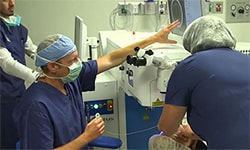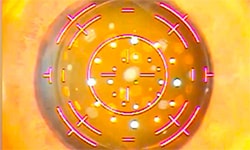Editorially Independent Content
The growth of femtosecond laser assisted cataract surgery is predominantly due to the reproducibility and uniformity of laser capsulotomies as well as the lens fragmentation capabilities. Zepto (Mynosys) is an exciting new technology designed to create a precise, automated capsulotomy by a method called precision pulse capsulotomy (PPC)1. The disposable handpiece would replace the capsulorhexis forceps during the normal surgical sequence and should therefore enhance rather than reduce surgical efficiency.
How it Works
A small console powers the disposable handpiece and capsulotomy tip. The cutting element is a nitinol ring with a precisely engineered micrometer edge that creates a 5.0 mm diameter capsulotomy. Nitinol is a shape-memory alloy so it can be deformed or compressed and it will rebound to its original shape. A thin, transparent silicone shell surrounds the nitinol ring that is stretched and elongated with a metal push rod to facilitate insertion through a 2.2mm clear corneal incision. The Zepto tip re-assumes the original shape once it is opened inside the anterior chamber filled with viscoelastic.
The surgeon gently positions the ring and surrounding silicone suction cup on the anterior capsular surface prior to applying a small amount of suction via the external console. Only slight suction is needed to appose the anterior capsule against the bottom edge of the nitinol ring, which has been precisely engineered at the micron scale to enable uniform cutting of the capsule. The silicone shell has a clear central opening which permits the patient to fixate on the microscope light filament during positioning of the device.
A series of rapid electrical micropulses create just enough heat to vaporize water molecules trapped between the anterior capsule and the nitinol ring. The phase transition happens so quickly (approximately 4 msec) that there is a simultaneous circumferential cleavage of the anterior capsule. The result is a complete circular and perfectly-sized capsulotomy with no tags, and without any tissue coagulation such as with cautery.
A Trial of Strength
An unexpected finding is the greater apparent strength of the PCC. Mynosys designed a force gauge machine to stress test the Zepto-created capsulotomy strength. This was compared to either a femto capsulotomy or a manual capsulorhexis performed in paired human cadaver eyes2. These results convincingly showed that the PCC was stronger than both manual and femto capsulotomy in terms of the resistance to tearing2.[1] This is of course potentially important considering concerns about the strength of femtosecond capsulotomies—a greater incidence of late tears of the anterior capsule reported in several studies3,4. Many believe this is due to scattered aberrant laser shots caused by microscopic eye movements during the laser capsulotomy step3.[2]
Working into Practice
Manual capsulorhexis is difficult for all of us in certain complicated cases, such as intumescent lenses or those with zonulopathy. Some surgeons might stock and use Zepto just for these challening cases, much like they use trypan blue dye and pupil expansion or capsule tension rings. Others may value the perfectly circular and precise dimensions for premium refractive IOL implantation.
Finally, some cataract surgeons may be tempted to use it on every case to improve efficiency and dependability. I think the cost model would make that feasible. The beauty of a disposable instrument is the versatility it provides to surgeons without the economic pressures of purchasing a femtosecond laser or the need for patients to pay extra for the technology.
Financial disclosure: David Chang has received compensation as a consultant for Abbott Medical Optics, Lensar, and Mynosys.
1. Chang DF, Mamalis N, Werner L. Precision Pulse Capsulotomy – Preclinical Safety and Performance of a New Capsulotomy Technology. Ophthalmology 2016; 123:255-264.
2. Thompson VM, Berdahl JP, Solano JM, Chang DF. Comparison of manual, femtosecond laser, and precision pulse capsulotomy edge tear in paired human cadaver eyes. Ophthalmology 2016;123:265-274.
3. Abell RG, Davies PE, Phelan D, et al. Anterior capsulotomy integrity after femtosecond laser-assisted cataract surgery. Ophthalmology 2014;121:17-24.
4. Chang JS, Chen IN, Chan WM, et al. Initial evaluation of a femtosecond laser system in cataract surgery. J Cataract Refract Surg 2014;40:29-36.





